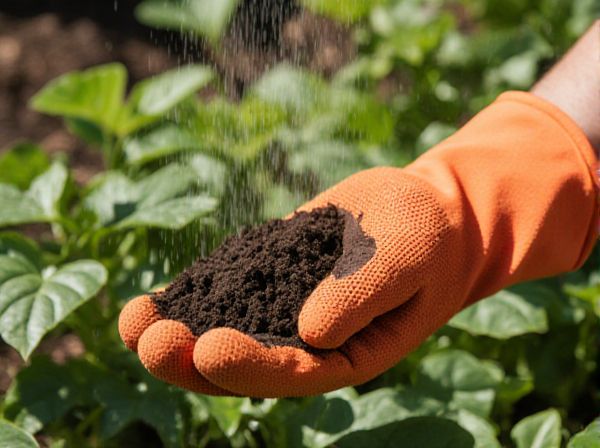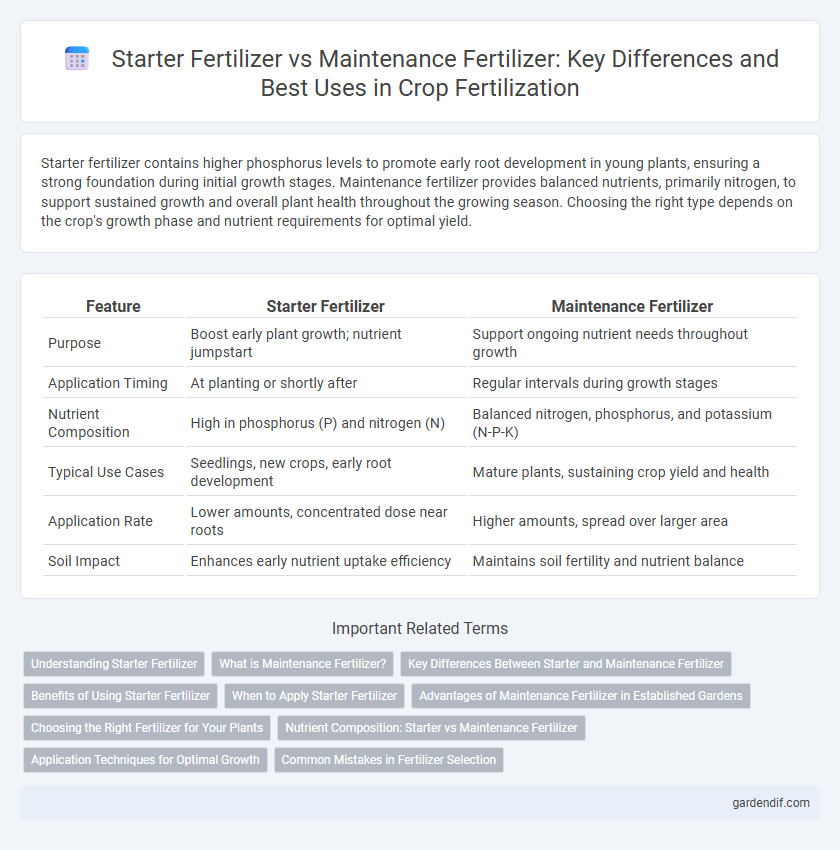
Starter fertilizer vs Maintenance fertilizer Illustration
Starter fertilizer contains higher phosphorus levels to promote early root development in young plants, ensuring a strong foundation during initial growth stages. Maintenance fertilizer provides balanced nutrients, primarily nitrogen, to support sustained growth and overall plant health throughout the growing season. Choosing the right type depends on the crop's growth phase and nutrient requirements for optimal yield.
Table of Comparison
| Feature | Starter Fertilizer | Maintenance Fertilizer |
|---|---|---|
| Purpose | Boost early plant growth; nutrient jumpstart | Support ongoing nutrient needs throughout growth |
| Application Timing | At planting or shortly after | Regular intervals during growth stages |
| Nutrient Composition | High in phosphorus (P) and nitrogen (N) | Balanced nitrogen, phosphorus, and potassium (N-P-K) |
| Typical Use Cases | Seedlings, new crops, early root development | Mature plants, sustaining crop yield and health |
| Application Rate | Lower amounts, concentrated dose near roots | Higher amounts, spread over larger area |
| Soil Impact | Enhances early nutrient uptake efficiency | Maintains soil fertility and nutrient balance |
Understanding Starter Fertilizer
Starter fertilizer delivers essential nutrients like nitrogen, phosphorus, and potassium directly to young plants, promoting strong root development and early growth. Its high phosphorus content is crucial for seedling establishment, ensuring plants access vital energy for growth processes. Applied at planting or shortly after, starter fertilizers enhance crop vigor and yield potential by improving nutrient availability during critical growth stages.
What is Maintenance Fertilizer?
Maintenance fertilizer is a type of nutrient supplement applied regularly to sustain optimal soil fertility and support ongoing plant growth after the initial establishment phase. It contains balanced amounts of essential nutrients such as nitrogen, phosphorus, and potassium to replenish the soil and prevent nutrient depletion. Unlike starter fertilizer, maintenance fertilizer ensures long-term plant health and productivity by continuously addressing nutrient demands throughout the growing season.
Key Differences Between Starter and Maintenance Fertilizer
Starter fertilizer contains higher concentrations of phosphorus to promote strong root development and early growth, while maintenance fertilizer provides balanced nutrients for ongoing plant health and sustained growth. Starter fertilizer is typically applied at planting time to ensure rapid seedling establishment, whereas maintenance fertilizer is used throughout the growing season to replenish soil nutrients. The distinct nutrient ratios and timing of application optimize crop yield and soil fertility management.
Benefits of Using Starter Fertilizer
Starter fertilizer delivers essential nutrients like phosphorus and nitrogen directly to young plants, promoting robust root development and early growth. This targeted nutrient boost enhances seedling vigor, leading to higher crop yields and improved stress resistance. Applying starter fertilizer ensures timely nutrient availability, optimizing plant establishment and setting the foundation for long-term field productivity.
When to Apply Starter Fertilizer
Starter fertilizer is applied at planting to promote early root development and improve nutrient uptake in young crops. This type of fertilizer typically contains higher concentrations of phosphorus and nitrogen essential for seedling growth. Applying it when soil temperatures are favorable ensures maximum nutrient availability and boosts crop establishment.
Advantages of Maintenance Fertilizer in Established Gardens
Maintenance fertilizer supports established gardens by providing a balanced supply of essential nutrients that sustain plant health and productivity over time. It helps replenish soil nutrient levels depleted through regular plant uptake and environmental factors, ensuring consistent growth and vitality. Using maintenance fertilizer reduces the risk of nutrient imbalances and promotes long-term soil fertility, leading to stronger, more resilient plants.
Choosing the Right Fertilizer for Your Plants
Starter fertilizer is formulated with higher phosphorus levels to promote strong root development in young plants, while maintenance fertilizer contains balanced nutrients to sustain healthy growth and productivity. Selecting the right fertilizer depends on the plant's growth stage and nutrient requirements, ensuring optimal nutrient availability without over-fertilization. Understanding soil nutrient content and specific crop needs helps in applying either starter or maintenance fertilizer effectively for maximum yield and plant health.
Nutrient Composition: Starter vs Maintenance Fertilizer
Starter fertilizer typically contains higher concentrations of phosphorus and potassium to promote root development and early plant growth, while maintenance fertilizer is balanced with nitrogen, phosphorus, and potassium to support ongoing nutrient requirements throughout the growing season. Starter fertilizers often have a nutrient ratio with elevated P2O5 content, such as 10-20-10, emphasizing root establishment, whereas maintenance fertilizers feature more uniform ratios like 10-10-10 or 15-15-15 to sustain plant health. The targeted nutrient composition in starter fertilizers accelerates seedling vigor, contrasting with the broader nutrient spectrum in maintenance fertilizers designed for steady growth and yield optimization.
Application Techniques for Optimal Growth
Starter fertilizer is applied directly to the seed zone at planting, ensuring immediate nutrient availability to young seedlings for enhanced root development and early growth vigor. Maintenance fertilizer is typically top-dressed during the growing season, providing sustained nutrient release to support ongoing plant health and yield optimization. Precise placement and timing of these fertilizers maximize nutrient uptake efficiency and crop performance.
Common Mistakes in Fertilizer Selection
Choosing between starter fertilizer and maintenance fertilizer often leads to common mistakes such as applying excessive nutrients early on, which can harm seedlings or cause nutrient imbalance. Misunderstanding the distinct nutrient compositions--starter fertilizers typically high in phosphorus for root development, while maintenance fertilizers emphasize nitrogen for sustained growth--results in ineffective feeding schedules. Ignoring soil tests before application also contributes to improper fertilizer selection, reducing crop yield and increasing environmental risks.
Starter fertilizer vs Maintenance fertilizer Infographic

 gardendif.com
gardendif.com